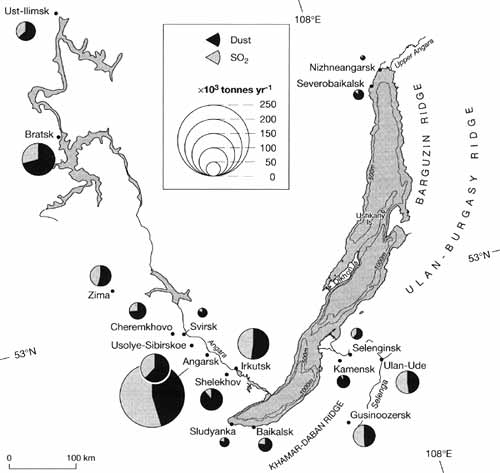Please put an active hyperlink to our site (www.rusnature.info) when you copy the materials from this page
Biomes and Regions of Northern Eurasia
Lake Baikal
<<< Environmental Change in Lake Baikal
| Biomes & Regions Index | The Far
East: Introduction >>>
Environmental Threats to Lake Baikal
Human influence around Lake Baikal has been evident since at least the Neolithic period
when small populations hunted nerpa (or Baikal seal, Phoca Sibirica) on a seasonal basis
(Weber et al., 1993). Asian populations, such as the Buryats and the Mongols have also
existed around Baikal for centuries, while the first Russian settlers did not arrive until
the mid-17th century. It has only been since the 1950s, however, that environmental
concerns for the lake developed into national and international issues. These concerns
focused mainly on point source pollution (from two paper and pulp mills built in the
1960s-l 970s in the towns of Baikalsk in the southern basin, and Selenginsk on the Selenga
river), and over-fishing. By the 1980s, the campaign against these industries gathered
pace, but had now extended to include logging of the catchment and overfishing. In the
late 1980s, thousands of nerpa died from a morbil-livirus (Grachev et al., 1989), and
environmentalists suggested that the seals' immune systems had been degraded by increasing
pollution levels, including persistent organic pollutants (POPs) and heavy metals
(Galazii, 1991). Furthermore, pollution from industrial and domestic wastes, increasing
eutrophication, uncontrolled fishing, and logging of the catchment were also linked to
declines in fish growth rates, the disappearance of endemic animals, and a general influx
of more cosmopolitan flora and fauna: Lake Baikal had become an international cause
celebre (Galazii, 1991; Maddox, 1987). For example, the baikalian Coregonus is
non-migratory and its numbers were severely depleted since the 1950s due to overflshing,
but since the introduction of catch controls, populations have increased significantly
(Atlas Baikala, 1993). On the other hand, many other scientists firmly believed that
changes in the biota of the lake can be explained by natural variation (e.g., Grachev,
1991) and during the 1990s, international research programmes were established to collate
scientific evidence on the past and present environmental state of Lake Baikal (under the
auspices of BICER Ч Baikal International Centre for Ecological Research).
It has recently been established that pollutants indicative of fossil fuel combustion
(e.g., spheroidal carbonaceous particles, SCPs) have increased over the last 50 years:
increases were greatest in the southern basin, although small increases were also evident
in the north basin (Rose et al, 1998). These increases closely mirror levels of fossil
fuel combustion in the catchment (Figure 17.8).

Fig. 17.8 Location of principal industries in the Baikal region.
Reproduced from Rose et al. (1998)
As well as SCPs, Falkner et al. (1997) suggest that vanadium input into the lake is
increasing, while Boyle et al. (1998) provide evidence for small increases in lead
concentration in the south basin. Minor element enrichment is not as clear-cut as for
SCPs, with Vetrov and Kuznetsova (1997) even suggesting that no enrichment is occurring.
Overall, pollution levels are similar to those of Northern Hemisphere background sites,
such as the Arctic.
Using diatom analysis in surface sediments, Mackay et al. (1998) found no evidence of
the endemic flora in the lake being affected by pollution (except for localized sites such
as the shallow waters of the Selenga's delta). Increasing numbers of cosmopolitan taxa
caused by pollution is suggested by Bondarenko (1999) but more detailed monitoring of the
aquatic ecosystem is necessary. Current levels of metals in Baikal are greatest in the
southern basin (Jambers and van Grieken, 1997), although Watanabe et al. (1996) dispute
that toxic metals, such as mercury and cadmium, could cause immunosuppression in Baikal
seals because concentrations are very low.
Perhaps the greatest threat to the lake's biota, especially the nerpa, lies with
increasing levels of POPs and DDT. It has been shown that the Baikalsk mill caused
enhanced levels of persistent organic chlorines in the southern basin (Maatela et al.,
1990). Trends are complicated however: in the air above Baikal, concentrations of POPs are
similar to remote regions, again like the Arctic (e.g., Iwata et al., 1995); levels in
fish are comparable to those in the Great Lakes in North America, while concentrations in
the nerpa are similar to animals found in, for example, more polluted European waters,
such as the Caspian Sea (Kucklick et al., 1994). Bioaccumulation of organic chlorine
compounds, including DDT and PCBs, in the nerpa is thus clearly a problem, even though the
physical environment of Baikal (i.e., water, sediments) contains relatively low levels of
pollutants (Nakata et al., 1995). A direct link has not yet been made between increasing
organochlorine pollution and morbidity and mortality in the nerpa, although mechanisms
have been proposed (Nakata et al., 1995, 1997). Much more research still needs to take
place, and it is encouraging in the meantime that several local measures to reduce
pollution in the lake have already been taken, such as converting the two paper and pulp
mills into closed systems.
<<< Environmental Change in Lake Baikal
| Biomes & Regions Index | The Far
East: Introduction >>>
Contents of the Lake Baikal section:
Other sections of Biomes & Regions:
|
|